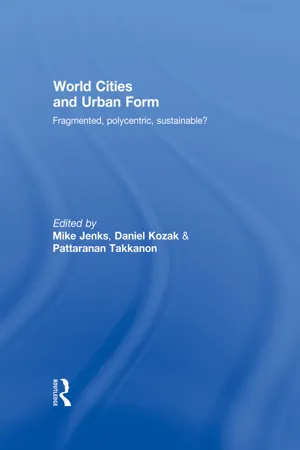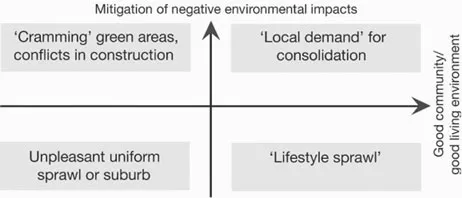
eBook - ePub
World Cities and Urban Form
Fragmented, Polycentric, Sustainable?
Mike Jenks,Daniel Kozak,Pattaranan Takkanon
This is a test
- 374 pages
- English
- ePUB (mobile friendly)
- Available on iOS & Android
eBook - ePub
World Cities and Urban Form
Fragmented, Polycentric, Sustainable?
Mike Jenks,Daniel Kozak,Pattaranan Takkanon
Book details
Book preview
Table of contents
Citations
About This Book
This book presents new research and theory at the regional scale showing the forms metropolitan regions might take to achieve sustainability. At the city scale the book presents case studies based on the latest research and practice from Europe, Asia and North America, showing how both planning and flagship design can propel cities into world class status, and also improve sustainability. The contributors explore the tension between polycentric and potentially sustainable development, and urban fragmentation in a physical context, but also in a wider cultural, social and economic context.
Frequently asked questions
How do I cancel my subscription?
Can/how do I download books?
At the moment all of our mobile-responsive ePub books are available to download via the app. Most of our PDFs are also available to download and we're working on making the final remaining ones downloadable now. Learn more here.
What is the difference between the pricing plans?
Both plans give you full access to the library and all of Perlego’s features. The only differences are the price and subscription period: With the annual plan you’ll save around 30% compared to 12 months on the monthly plan.
What is Perlego?
We are an online textbook subscription service, where you can get access to an entire online library for less than the price of a single book per month. With over 1 million books across 1000+ topics, we’ve got you covered! Learn more here.
Do you support text-to-speech?
Look out for the read-aloud symbol on your next book to see if you can listen to it. The read-aloud tool reads text aloud for you, highlighting the text as it is being read. You can pause it, speed it up and slow it down. Learn more here.
Is World Cities and Urban Form an online PDF/ePUB?
Yes, you can access World Cities and Urban Form by Mike Jenks,Daniel Kozak,Pattaranan Takkanon in PDF and/or ePUB format, as well as other popular books in Architektur & Stadtplanung & Landschaftsgestaltung. We have over one million books available in our catalogue for you to explore.
Information
Section Two
Polycentric Regions and Cities:
Perspectives from Europe, Asia and North America

Fig. (opposite page). Den Haaga polycentric node of government offices and sustainable modes of transport, and a main rail station close by, providing efficient public transport interconnecting with the Randstad metropolitan region
6
Promoting Sustainable Urban Form:
Implementing urban consolidation policies around the Helsinki Metropolitan Region
Introduction
Urban sprawl is recognised as a major environmental, economic and social challenge in many growing European cities, likewise in the Helsinki Metropolitan Region. Urban sprawl and anti-sprawl policies are in many ways linked to the questions of urban sustainability, increasing fragmentation and polycentric development. In the world city debate the practical experiences of these linkages are needed.
This chapter assesses the ways in which development is steered towards consolidating the urban structure in the margins of the Helsinki Metropolitan Area. The research focuses on two satellite towns, Hyvinkää and Lohja, whose development is very much connected to the development of the Helsinki region. Hyvinkää has both rail and motorway connections to Helsinki, while Lohja has only a motorway. The chapter focuses specifically on the policies and procedures of these two cities.
The aim is to ascertain why some municipalities seem to have been successful in developing an integral, consolidated urban structure while others have not. In the case of the Helsinki Metropolitan Area, an assessment is made as to whether it is possible that satellite cities might promote sustainable regional growth (anti-sprawl). Of particular interest are the measures that are taken locally by municipalities to promote urban consolidation in planning, the guiding instruments that are used, and the problems that might get in the way of a consolidation policy. Collectively such implementation measures represent an operative policy for consolidation, and the term ‘urban consolidation policy’ refers to an urban anti-sprawl policy by which both urban structure and the quality of the living environment are improved.
The concept of urban consolidation policy in Finland
In the context of the international debate on sustainable urban form, official urban planning recommendations in Finland have for a long time promoted a densificationoriented policy. By the late 1990s, densification policy was replaced by the concept of urban consolidation, which was considered, officially at least, to give a greater emphasis to aspects of quality related to urban compaction. Despite the emphasis that the concept receives in official goal setting, it has not been explained; no official definition, or any kind of white paper, exists about either the concept or the policy.
The most important legal land-use guidance document that does include the concept is the National Land-Use Guidelines of Finland, one of the main objectives of which is ‘a more consolidated urban structure and the quality of the living environment’. The guidelines state that
the well-functioning and the economy of living environments is to be promoted by means of utilising and consolidating existing urban structures. In the consolidation of urban structures, the quality of the living environment should be improved. Urban structures are to be developed so as to make services and workplaces available to different groups of the population … (Ministry of the Environment, 2002).
This suggests that there might exist a large variety of different interpretations of the concept and the policy at the local level, and also between different actors in the same local policy network.
The term ‘urban consolidation policy’ is used here to refer to an urban development policy where both urban structure and the quality of the living environment are improved. Thus, the target of an urban consolidation policy is to:
- improve the eco-efficiency of the urban structure (e.g. through densification);
- diminish negative environmental impacts and;
- improve the quality of services.
The quality of services can, in this context, imply a ‘good living environment’, ‘good accessibility of services’ or ‘good public transport’. So the concept of consolidation concerns all three aspects of sustainability: ecological, economic and social/cultural.
The content of a consolidation policy can be illustrated by placing its various dimensions in a grid, where the X axis is the quality of services, and the Y axis the mitigation of negative ecological impacts. Urban consolidation would, in the best-case scenario, be located in the upper right-hand cell of the grid. The other typical concepts and situations in consolidation policy discourse can also be placed in the grid (Fig. 1).
Fig. 1. Consolidation policy and the dimensions of eco-efficiency
Source: Maijala and Sairinen
Source: Maijala and Sairinen

The principal operational concept of urban consolidation is accessibility. It embodies a central social-ethical dimension of urban consolidation: consolidation can be seen as a policy of facilitation which seeks to guarantee all people and groups equal access to the services and quality functions of the community and living environment that are vital to them. When complemented with an ecological/ethical dimension which emphasises the reduction of energy consumption and negative environmental impacts, it results in developing communities and living environments that facilitate access to functions and individual quality factors, in particular, by walking, bicycle or public transportation, i.e. living environments with ‘affordances for an ecological lifestyle’ (Kyttä and Kahila 2005 and 2006). This is above all egalitarian facilitation, supporting environmentally and socially sustainable choices. Structure, the end result of planning, has a probabilistic role in this process. How people ultimately act and choose is something that cannot be dictated by community planning.
Policy instruments for urban consolidation policy
Nuissl (2007), complementing and modifying the basic categorisation employed by Bengston et al. (2004), has divided policy instruments for ‘smart sprawl’ into four categories:
- Regulation – ‘hard’ legal instruments
- Incentives
- Public management – ‘soft’ instruments such as regional co-operation
- Information / education
The same classification scheme can also be used for an analysis of the instruments of an urban consolidation policy.
Regulation
The lack of legal regulatory instruments is not a problem, at least in Western Europe (Nuissl, 2007). The main problem seems to be the lack of willingness to use these instruments. There are many actors on different levels who oppose any restrictions on urban growth and supplementary development. Nuissl distinguishes between three main types of actors as ‘users of anti-sprawl planning’:
- Core cities tend to be the natural allies for anti-sprawl policies.
- Urban sprawl is often exacerbated by edge cities, which usually attract businesses and inhabitants with a total disregard for future costs. The growth of such cities is often perceived as sprawl from the perspective of the region, or at least from that of the core city.
- Regional actors should be able to implement policies that mitigate urban sprawl.
There are two ways that regional land-use planning can be used to efficiently control suburbanisation: vertical and horizontal co-ordination. Vertical co-ordination is the harmonisation of municipal planning with more general goals. Horizontal co-operation balances conflicts between municipalities. In the Finnish context, the former refers to the traditional planning hierarchy between municipal and regional planning, the latter to the currently topical development of urban regional planning. According to Nuissl, one of the potential obstacles to successful regional cooperation is that local disinterest in anti-sprawl policy also operates on the regional level. Moreover, the regional level is easily beset with conflicts.
Incentives
One possible way of implementing an anti-sprawl policy is to try to influence the behaviour of actors that lead to urban sprawl. In practice, suburbanisation must be made to appear less attractive by altering incentives and the dynamics of development.
Public policy has two main instruments with which to alter the attractiveness of urban sprawl: by making sprawl-inducing behaviour more expensive and by reducing the attractiveness of some environments vis-à-vis others. Features that make suburbs attractive can be imported to inner cities, and perceived inner city disadvantages can be mitigated. There is an interesting contradiction in the case of public transportation policy: new or faster connections to suburbs tend to increase the attractiveness of decentralisation. On the other hand, new connections help to diminish the volume of private car traffic in inner city areas, thus making inner cities more attractive.
Public management
Nuissl’s third group of policy instruments consists of a variety of ‘soft’ measures, i.e. non-regulatory and informal actions in which the public sector occupies a central role. In practice, such instruments are used to try to find cooperation-based solutions to specific problems that concern conflicting demands on land use. In reality, this comprises municipal collaboration and collaboration between municipalities and the state, where the key aspect is commitment to a common goal. As Nuissl points out, it is no surprise that such soft planning instruments are fa...
Table of contents
- Cover
- Half Title
- Title Page
- Copyright Page
- Table of Contents
- Contributors
- Acknowledgements
- Introduction
- Section One: Theoretical Approaches in a Global Context
- Section Two: Polycentric Regions and Cities: Perspectives from Europe, Asia and North America
- Section Three: Aspects of Fragmentation and Polycentrism
- Conclusion
- Index
Citation styles for World Cities and Urban Form
APA 6 Citation
[author missing]. (2013). World Cities and Urban Form (1st ed.). Taylor and Francis. Retrieved from https://www.perlego.com/book/1547092/world-cities-and-urban-form-fragmented-polycentric-sustainable-pdf (Original work published 2013)
Chicago Citation
[author missing]. (2013) 2013. World Cities and Urban Form. 1st ed. Taylor and Francis. https://www.perlego.com/book/1547092/world-cities-and-urban-form-fragmented-polycentric-sustainable-pdf.
Harvard Citation
[author missing] (2013) World Cities and Urban Form. 1st edn. Taylor and Francis. Available at: https://www.perlego.com/book/1547092/world-cities-and-urban-form-fragmented-polycentric-sustainable-pdf (Accessed: 14 October 2022).
MLA 7 Citation
[author missing]. World Cities and Urban Form. 1st ed. Taylor and Francis, 2013. Web. 14 Oct. 2022.